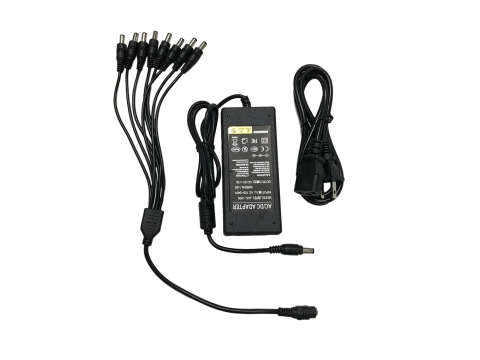Powering Surveillance Cameras: Key Points
Proper power supply is critical for the effective operation of surveillance systems. Cameras typically use one of the following power sources:
- 12V DC (most common)
- 24V DC
- 220V AC
Each power source has unique pros and cons, including ease of setup and safety considerations. For example, low-voltage DC options (12V and 24V) are safer but require careful planning to avoid power loss over long cable runs.
Cables for Surveillance Cameras
Choosing the right cable is crucial to minimize power loss and maintain consistent performance. Commonly used cables include:
- SHVVP 2x0.5 or 2x0.75: Flexible and easy to install, ideal for low-power systems.
- KVK Combo Cable: Combines power and video transmission in a single cable, simplifying installation for analog systems.
For IP cameras, use Ethernet cables (Cat 5e or Cat 6) for both data and power when employing PoE technology.
Powering IP Cameras with PoE Technology
Power over Ethernet (PoE) simplifies wiring by combining data and power transmission in a single Ethernet cable. Components include:
- PoE Sources (PSE): Includes PoE switches and injectors.
- PoE Splitters: Converts PoE to separate power and data for non-PoE cameras.
- PoE Cameras (PD): Cameras designed to receive power directly over Ethernet.
PoE reduces the need for separate power lines, making it ideal for IP surveillance systems.
Power Supplies and UPS Options
Choosing the Right Power Block
- Voltage: Match the camera’s requirements (e.g., 12V DC).
- Current (Amps): Ensure the block can handle the combined load of all connected cameras.
- Stabilization: Consider stabilized blocks for systems prone to power fluctuations.
Uninterrupted Power Supplies (UPS)
UPS systems are essential for critical surveillance setups. To calculate UPS capacity:
- Sum the power requirements of all devices (cameras, recorders).
- Add a 20-30% buffer for efficiency.
- Choose batteries with sufficient capacity for desired backup duration.
Example: For 3 cameras consuming 1.5A each, a 7Ah battery provides about 3 hours of backup.
Calculating Cable Parameters
For reliable power delivery, calculate the required cable gauge to minimize voltage drop:
- Calculate Total Current: Add the current draw of all cameras.
- Determine Voltage Drop: Use Ohm’s Law , where is the cable resistance.
- Choose Cable Gauge: Ensure the chosen cable's resistance meets the voltage tolerance of the system.
Conclusion
A well-planned power supply setup ensures reliable performance and longevity of your surveillance system. Whether you’re powering an analog setup, an IP system with PoE, or using UPS for critical operations, proper calculations and high-quality components are key to success.

